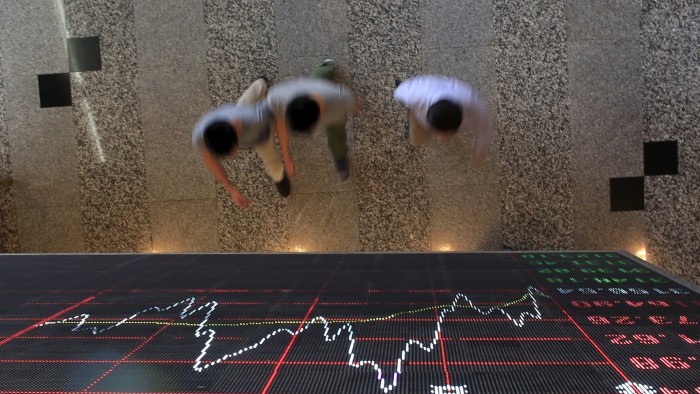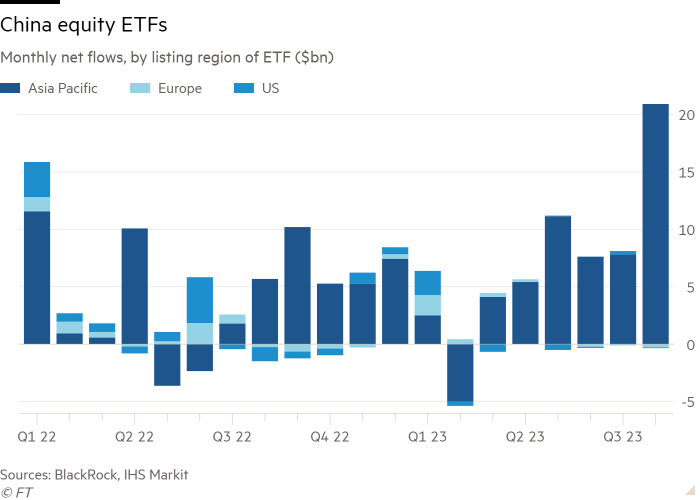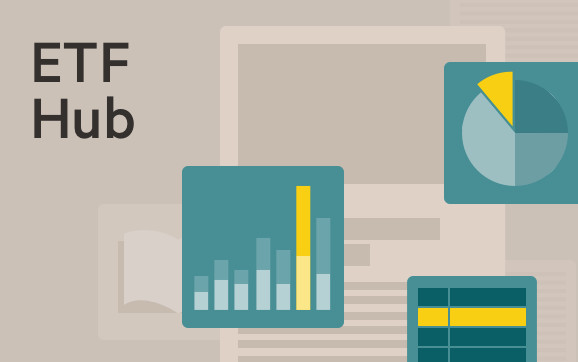China attracts record ETF flows even as US and Europeans pull out

Simply sign up to the Exchange traded funds myFT Digest -- delivered directly to your inbox.
Latest news on ETFs
Visit our ETF Hub to find out more and to explore our in-depth data and comparison tools
A push by Beijing to pump money into Chinese equity markets appears to have prompted a surge in investment resulting in China accounting for almost a third of global exchange traded fund flows in August.
China-focused equity ETFs saw record net inflows of $20.6bn in August, two-and-a-half times the level in July, according to data from BlackRock, dwarfing the $11.1bn pulled in by ETFs focused on US equities. The money that poured in all came from Asia Pacific-listed funds including China, with US and European investors actually pulling money out.
The BlackRock data does not provide a granular view of exactly where in the Apac region the flows originated, but it coincided with the introduction of multiple official measures to stimulate the Chinese stock market. Beijing halved the stamp duty on stock trading last month, while management fees have been cut on more than 70 per cent of actively managed funds, according to data from Wind, after the China Securities Regulatory Commission lowered the maximum fee funds can charge.
The CSRC also fast-tracked the approval of 17 ETFs — all focused either on small companies or technology stocks — as well as 20 mutual funds, on a single day last month.
The measures are being seen by observers as part of a push by Beijing to stimulate China’s stumbling equity market, with the blue-chip CSI 300 index still 35 per cent below the February 2021 peak.

As of September 5, the Chinese ETF market had Rmb2.91tn ($400bn) of assets, up 24 per cent so far this year, according to China Business News, a respected Chinese newspaper, despite the CSI 300 being down 3.1 per cent year-to-date.
Z-Ben, a Shanghai-based consultancy, said that in just eight trading days last month four China-listed ETFs tracking the CSI 300 had attracted $4.4bn in inflows, bringing their combined assets to more than $25bn and potentially suggesting buying by the “national team” — a term coined in 2015 to describe large state-affiliated institutions that intervened to prop up the market.
In contrast, demand among overseas investors for Chinese ETFs has been non-existent — with net outflows of $1bn since March — amid a backdrop of weak economic growth and mounting geopolitical tensions.
“Over the summer we have seen multiple measures of stimulus across different segments of the economy in China [but] foreign sentiment remains downbeat,” said Karim Chedid, head of investment strategy for BlackRock’s iShares in the Emea region.
Matthew Bartolini, head of SPDR Americas research at State Street Global Advisors, whose analysis is focused purely on US-listed ETFs, said “given the concerns over China, emerging market funds had over $1bn of outflows. Similarly, outflows in single-country China and Taiwan funds led that category to post flat flows.”
BlackRock announced the imminent closure of its Luxembourg-domiciled China Flexible Equity Fund on August 31 due to “a lack of new investor interest” amid China’s faltering economic recovery and an ongoing slowdown in mainland stocks.
The six-year-old fund had attracted just $21.4mn of assets despite being available for sale in almost two dozen markets across Europe, Hong Kong and Singapore.
On September 8, VanEck said it planned to close its US-listed China Growth Leaders ETF (GLCN), launched in 2010.
A record 14 emerging market equity funds that exclude China have launched so far this year, surpassing last year’s record high full-year tally of 13, according to data from Bloomberg, including vehicles from BlackRock, Goldman Sachs Asset Management and Lazard.
Globally, demand for ETFs of all stripes was muted in August, with total net inflows falling to $65.3bn, from $90.1bn in July, despite the $13bn jump in Chinese equity ETF buying, the BlackRock figures show. Flows into both equity and fixed income slowed, while commodity ETFs saw another month of outflows, driven by gold, continuing a recent trend.
In particular, net flows into US equity ETFs “dropped sharply” from $39bn in July to just $11.1bn in August — little more than half the Chinese figure and only the fourth time the US has been eclipsed by China since January 2021.
As a result, the US represented just 24 per cent of equity flows, well below July’s 65 per cent.
Chedid attributed the slump in part to a “summer lull”, with August typically a quiet month for flows. However, he also detected some “de-risking”, driven by the economic backdrop.
“In July, the main narrative was around a soft landing, averting recession but with inflation still falling, but in August that changed a bit,” he said, with “a back-up in yields” and “increasing fears that growth will remain higher than expected and rates will remain higher for longer”.
Bartolini painted a similar picture, with “rising rates and fears of a growth-slowdown spillover from China”, combining to hand a standard 60/40 equity-bond portfolio its worst monthly losses since February, pushing such a portfolio more than 10 per cent below the high-water mark set in 2021.
Latest news on ETFs

Visit the ETF Hub to find out more and to explore our in-depth data and comparison tools helping you to understand everything from performance to ESG ratings
Year-to-date net inflows in the US were just $292bn, Bartolini said, meaning the industry was on track to miss the $500bn figure it had posted for the past three years.
On a global basis, fixed income flows slowed from $32.1bn to $22.3bn. Even this buying was defensively focused, with government bonds ETFs accounting for $18.5bn, or 83 per cent, of this, well above the May to July average of 46 per cent. German Bund ETFs took in $0.8bn, their highest inflows since March 2020.
Nothing can seemingly halt the rise of technology-focused equity ETFs, though, as they vacuumed up another $12.2bn in August.
“With a cumulative $33bn of inflows YTD, tech sector flows have already surpassed the $26bn added over 2022, putting the sector on track to be the most popular for the fifth year running,” Chedid said.
Comments